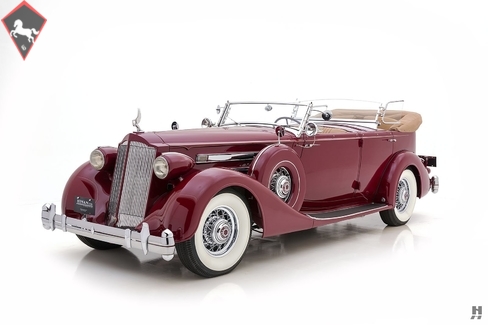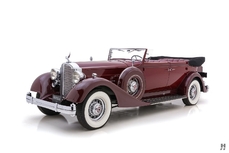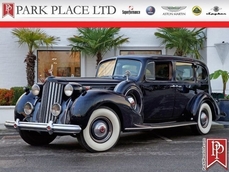Packard Twelve Dual Cowl Sport Phaeton 1936
Allgemeine Beschreibung :
While the Fourteenth Series of 1936 changed little from the 1935 Twelfth Series, the latest Packard served as a bridge between two significant eras in the company’s illustrious history. The twelve-cylinder models remained Packard’s top offering, with the Super Eight, Eight, and Junior series positioned below. Packard design had reached a turning point, which now firmly embraced the modern streamline era with its full-figured proportions, raked radiator shell, and aerodynamic detailing. Mechanically, it was a mix of modern and traditional, with the solid front axle suspension holding on for one more year, paired with powerful vacuum-assisted hydraulic brakes, synchronized gearbox, and finely tuned ride and handling. The flagship Twelve featured a 473 cubic-inch L-head V12, making 175 horsepower, matching the output of Cadillac’s complex OHV V16. By the second half of the decade, demand for lavish custom coachwork was waning, and customer tastes tended to favor more conservative and practical designs. Catalog custom designs by Deitrich, Le Baron, and Brunn continued to be offered, but they were produced in minuscule numbers compared to the standard Packard body-shop offerings.
This 1936 Packard 1407 Twelve is a stunning example of the 14th Series, equipped from new with beautifully proportioned and elegant Dietrich-designed Phaeton coachwork. It is offered with an older but finely preserved concours-quality restoration, finished in bold and striking colors, and equipped with a host of period accessories. It was updated with an accessory rear cowl and windscreen at the time of refurbishment, transforming it into a glamorous dual-cowl Phaeton. Since then, it has been maintained in excellent condition by a series of dedicated, knowledgeable enthusiasts. The gorgeous coachwork is resplendent in its vibrant maroon paintwork, which is smooth, glossy, and consistent with this being a former concours car. The body features numerous authentic accessories and options, including dual side-mount spares with matching hard-shell covers, Packard See Rite mirrors, Cormorant mascot, dual search lamps, chrome hood vents, and more. It has the low and purposeful stance that defines this generation of Packard, made particularly dramatic by 139-inch wheelbase, substantial vibration-dampening bumpers, wide whitewall tires, and chrome wire wheels.
Looking inside, we find tan leather upholstery finished to a high standard that displays a pleasing, lightly broken-in character. More fine details abound, including gorgeous woodgrain finishing on the dash and steering wheel, a marble shift knob, and fully restored instruments, controls, and switchgear. A factory Packard radio is integrated into the instrument panel. All four door panels are upholstered in matching tan leather, and the rears feature lovely, ornate wood trim. Rear passengers enjoy a spacious rear bench, folding footrest, and of course, the signature rear cowl and windscreen, which not only adds visual appeal but aids in the preservation of expensive hairstyles over a long journey.
For 1936, the Packard V12 displaced 473 cubic inches and produced an impressive 175 horsepower and a vast torque reserve for effortless forward progress. Beyond the numbers, though, the twelve’s unparalleled refinement put it at the top of the luxury car market in the late 30s. This car’s L-head V12 is correctly detailed in the signature Packard Green engine paint, with black porcelain manifolds and accessories. Some porcelain enamel has “baked- off” over time, but the engine remains tidy and appropriately well-finished. With some straightforward preparation, this car would be a superb choice for touring.
The Packard Twelve Dual-Cowl Phaeton is arguably the ultimate expression of prestige and luxury in the 1930s. This beautiful 1407 benefits from a high-quality restoration, which has mellowed just enough to make it the ideal choice for touring with groups like the Classic Car Club of America, Packard Club, and more. While ideally suited to on-road enjoyment, its beautifully maintained nature means it would still be a welcome sight for display in a variety of concours events around the country. Elegant, glamorous, and with enormous presence, this marvelous Packard is sure to please any enthusiast, from a seasoned veteran to a newcomer to the joys of Classic Era motoring.
Offers welcome and trades considered
https://hymanltd.com/vehicles/6778
1936 Packard Twelve Dual Cowl Sport Phaeton is listed verkauft on ClassicDigest in St. Louis by Mark Hyman for $239500.
Fakten der Auto
Karosserietyp : Auto Marke : Packard Modell : Twelve Ausführung : Dual Cowl Sport Phaeton Hubraum : 0.0 Modelljahr : 1936 Lage : Missouri
Verkauft
Angaben Zum Verkäufer
Verkauft
People who viewed this Packard Twelve also viewed similar Packard listed at ClassicDigest
Other cars listed for sale by this dealer
über Packard
Packard: Eine umfassende GeschichteFrühe Jahre und Stiftung:
Gründung: Die Packard Motor Car Company wurde 1899 in Warren, Ohio, von James Ward Packard, William Doud Packard und George Lewis Weiss gegründet.
Pionierluxus: Packard produzierte zunächst hochwertige Automobile und wurde zum Synonym für Luxus, Handwerk und technische Exzellenz.
Bemerkenswerte Erfolge und Beiträge:
Packard Twin Six: Das 1916 eingeführte Auto wurde Packard als Premier Luxury Automobile Marke eingerichtet.
Modelllinienerweiterung: Packard hat seine Aufstellung mit verschiedenen Modellen erweitert, darunter Limousinen, Coupes, Cabrios und Limousinen, die an wohlhabende Kunden geliefert werden, die Eleganz und Leistung suchen.
Engineering Innovations: Die Marke führte mehrere Innovationen ein, z.
Zehn historisch bedeutende Modelle mit technischen Spezifikationen:
Packard Twin Six (1916):
Motor: 7.3L V12 Motor.
Leistung: rund 85 PS.
Packard acht (1930-1938):
Motor: Straight-8 Motor mit verschiedenen Verschiebungen.
Leistung: reicht zwischen 90 und über 130 PS.
Packard Super Eight (1939-1951):
Motor: Straight-8 Motor.
Leistung: Produktion zwischen 130 und 180 PS.
Packard One-Twenty (1935-1942):
Motor: Straight-8 Motor.
Leistung: ca. 100 bis 120 PS.
Packard Clipper (1941-1957):
Motor: V8 Motor.
Leistung: reichen von 135 bis 185 PS.
Packard Caribbean (1953-1956):
Motor: V8 Motor.
Leistung: variiert zwischen 275 und 310 PS.
Packard Patrician (1951-1956):
Motor: Inline-8- und V8-Motoren.
Leistung: reicht von 150 bis 180 PS.
Packard Hawk (1958):
Motor: V8 Motor.
Leistung: Erzeugt um 275 PS.
Packard Executive (1956-1958):
Motor: V8 Motor.
Leistung: variiert zwischen 240 und 290 PS.
Packard Predictor (1956):
Motor: Konzeptauto präsentieren Design und Technologie.
Leistung: Prototypmodell.
Vermächtnis und Einfluss:
Qualität und Eleganz: Packard wurde wegen seiner außergewöhnlichen Verarbeitungsqualität, des raffinierten Stylings und seiner Luxusmerkmale verehrt, die häufig mit europäischen Luxusmarken wie Mercedes-Benz auf A-A-Niveau berücksichtigt wurden.
Produktionsende: Die Marke hatte in den 1950er Jahren finanzielle Kämpfe, was zu ihrer Fusion mit Studebaker und letztendlich Ende der 1950er Jahre führte, was das Ende einer Ära in amerikanischen Luxusautomobilen kennzeichnete.
Packard hinterließ ein dauerhaftes Erbe in der Automobilindustrie, symbolisierte Eleganz, technische Exzellenz und ein Engagement für Luxus, das weltweit von Autoenthusiasten bewundert und respektiert wurde.









